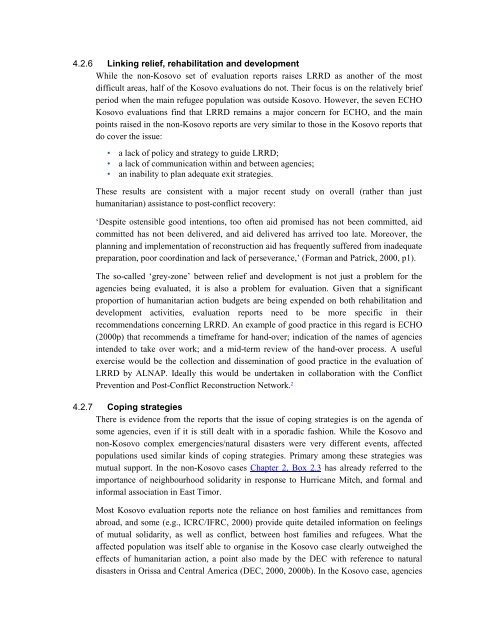Download PDF - ReliefWeb
Download PDF - ReliefWeb
Download PDF - ReliefWeb
Create successful ePaper yourself
Turn your PDF publications into a flip-book with our unique Google optimized e-Paper software.
4.2.6 Linking relief, rehabilitation and development<br />
While the non-Kosovo set of evaluation reports raises LRRD as another of the most<br />
difficult areas, half of the Kosovo evaluations do not. Their focus is on the relatively brief<br />
period when the main refugee population was outside Kosovo. However, the seven ECHO<br />
Kosovo evaluations find that LRRD remains a major concern for ECHO, and the main<br />
points raised in the non-Kosovo reports are very similar to those in the Kosovo reports that<br />
do cover the issue:<br />
• a lack of policy and strategy to guide LRRD;<br />
• a lack of communication within and between agencies;<br />
• an inability to plan adequate exit strategies.<br />
These results are consistent with a major recent study on overall (rather than just<br />
humanitarian) assistance to post-conflict recovery:<br />
‘Despite ostensible good intentions, too often aid promised has not been committed, aid<br />
committed has not been delivered, and aid delivered has arrived too late. Moreover, the<br />
planning and implementation of reconstruction aid has frequently suffered from inadequate<br />
preparation, poor coordination and lack of perseverance,’ (Forman and Patrick, 2000, p1).<br />
The so-called ‘grey-zone’ between relief and development is not just a problem for the<br />
agencies being evaluated, it is also a problem for evaluation. Given that a significant<br />
proportion of humanitarian action budgets are being expended on both rehabilitation and<br />
development activities, evaluation reports need to be more specific in their<br />
recommendations concerning LRRD. An example of good practice in this regard is ECHO<br />
(2000p) that recommends a timeframe for hand-over; indication of the names of agencies<br />
intended to take over work; and a mid-term review of the hand-over process. A useful<br />
exercise would be the collection and dissemination of good practice in the evaluation of<br />
LRRD by ALNAP. Ideally this would be undertaken in collaboration with the Conflict<br />
Prevention and Post-Conflict Reconstruction Network. 2<br />
4.2.7 Coping strategies<br />
There is evidence from the reports that the issue of coping strategies is on the agenda of<br />
some agencies, even if it is still dealt with in a sporadic fashion. While the Kosovo and<br />
non-Kosovo complex emergencies/natural disasters were very different events, affected<br />
populations used similar kinds of coping strategies. Primary among these strategies was<br />
mutual support. In the non-Kosovo cases Chapter 2, Box 2.3 has already referred to the<br />
importance of neighbourhood solidarity in response to Hurricane Mitch, and formal and<br />
informal association in East Timor.<br />
Most Kosovo evaluation reports note the reliance on host families and remittances from<br />
abroad, and some (e.g., ICRC/IFRC, 2000) provide quite detailed information on feelings<br />
of mutual solidarity, as well as conflict, between host families and refugees. What the<br />
affected population was itself able to organise in the Kosovo case clearly outweighed the<br />
effects of humanitarian action, a point also made by the DEC with reference to natural<br />
disasters in Orissa and Central America (DEC, 2000, 2000b). In the Kosovo case, agencies
















![CynefinFramework final [Read-Only]](https://img.yumpu.com/19017304/1/190x135/cynefinframework-final-read-only.jpg?quality=85)